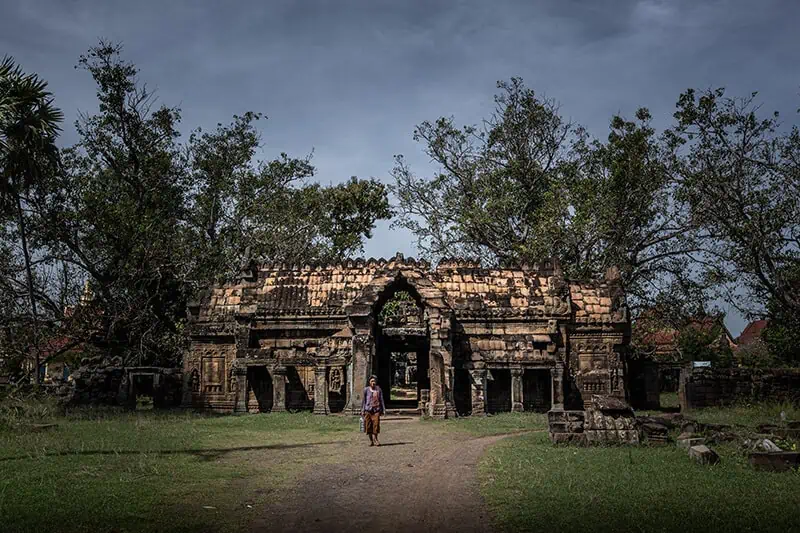Compared to its neighboring countries, nature in Cambodia doesn’t seem to get much limelight. The country is on many travelers’ bucket lists for its remarkable past; revered as a land of ancient wonders, Cambodia is home to some of the world’s most fascinating historical sites. But there’s another side to Cambodia – beyond its rich history and archaeological marvels, the country boasts a breathtaking array of natural sites, waiting to be explored.
In this blog post we’ll delve into the enchanting realm of nature in Cambodia, from its wildlife sanctuaries, to its dense jungles and fierce waterfalls. Read on to find out how to explore the diverse and remarkable nature of this country.
National Parks and Nature Sanctuaries in Cambodia
Phnom Kulen National Park
Located within the Siem Reap Province, this National Park is both a historic and natural treasure. Phnom Kulen is a revered site with deep historical significance, as it’s regarded as the birthplace of the ancient Khmer Empire – it was here that King Jayarvarman II had himself declared the ‘King of Kings’.

Visitors are drawn to Phnom Kulen for its lush verdant landscapes, serene waterfalls, and ancient temples. It’s a great place to explore Cambodian nature at its most beautiful, through the activities on offer which include hiking, swimming and discovering hidden archaeological sites.

Tonle Sap Biosphere Reserve
This UNESCO Biosphere Reserve is one of the most unique examples of nature in Cambodia – so unique that it’s regarded as one of the world’s most interesting ecosystems. What makes Tonle Lap so interesting is its seasonal reversal of water flow – during the monsoon season, the central lake in the reserve expands by up to five times.

The Biosphere Reserve is a haven for diverse flora and fauna including rare and endangered species like the Siamese Crocodile and the Mekong Giant Catfish. This makes it a fantastic place for nature spotting! In addition to this, over a million people call Tonle Sap home, living in houses on stilts and in floating villages. Visitors can tour these villages and learn more about life here, as well as shopping at floating markets and discovering local fishing techniques.
Prek Toal Bird Sanctuary
Within Tonle Sap Biosphere Reserve lies one of Cambodia‘s best wildlife sanctuaries, the Prek Toal Bird Sanctuary. Established to protect endangered bird populations and their habitats, this sanctuary is a fantastic spot for wildlife lovers visiting Cambodia.

Visitors are treated to sightings of rare and migratory birds including the spot-billed pelican, painted stork, and greater adjutant. The wetland ecosystems that can be found within the sanctuary support a rich variety of native flora and fauna, making it a great place to visit if you’re interested in learning about nature in Cambodia.
Virachey National Park
Spanning a whopping 3,380.57 km², Virachey National Park is another impressive place to visit if you’re looking to enjoy Cambodia’s nature. The park is one of two of Cambodia’s ASEAN Heritage Parks, a protective title given to areas within the ASEAN region recognized for their unique ecosystems and biodiversity.
This pristine wilderness is a haven for animal enthusiasts, as it’s home to elusive species including the clouded leopard, sun bear, and siamese crocodile – whilst sightings of these endangered animals are rare, exploring their habitats and wondering what could be lurking within the bushes is a thrilling experience nonetheless.
The park’s rugged landscapes, dense rainforests, and cascading waterfalls offer the perfect backdrop for activities like trekking and birdwatching – it’s a fantastic destination to experience nature in Cambodia.
Preah Monivong Bokor National Park
An hour away from the center of Kampot, you can find Preah Monivong National Park – the second of Cambodia’s two ASEAN Heritage Parks. The National Park is situated with the Damrei mountains, at an elevation of over 1000 m above sea level; the views are unmatched, making it a popular destination for hikers. Bokor is home to some of Cambodia’s most enthralling wildlife – black bears, pig-tailed macaques and pleated gibbons all reside here.
In addition to spectacular scenery and exciting wildlife, Bokor National Park is popular with travelers for another, more unexpected reason. Bokor Hill Station was built in the park by French Colonialists in the 1920’s. The buildings were abandoned during the Indochina war and many remain untouched today, lying derelict amongst the Cambodian jungle. It’s an eerie sight, and in recent years it’s become a popular place for tourists to explore.

Natural Gems: Waterfalls, Forests and Coral Reefs
Bou Sra Waterfall
The Bou Sra Waterfall is located in the Mondulkiri Province, close to the border with Vietnam. This triple-drop waterfall is considered to be one of Cambodia’s most beautiful natural attractions, and although you can find multiple waterfalls within Mondulkiri – this one is by far the most impressive.

Each stage of the waterfall increases in both height and width, creating a total height of 150 m at the top stage – as you can imagine, this creates quite a force of water. The fierce roar of water cascading over the rocks is deafening, especially when swimming in the pool at the foot of the falls. A visit to Bou Sra Waterfall is a great way to enjoy nature and escape from the summer heat.
Mondulkiri Forest
The province of Mondulkiri is one of the most remote and sparsely populated areas within Cambodia, and it contains thick jungles teeming with an incredible range of wildlife. Some of the country’s last wild elephants can be found here, as well as leopards, Siamese crocodiles and many more endangered species. It’s one of the most bio-diverse areas within South East Asia, with some people nicknaming it ‘the Serengeti of Asia’.

A huge scheme has been rolled out within Mondulkiri to reintroduce tigers into Cambodia, which have been extinct in the country since 2007. It’s been identified as a great location for the reintroduction of the species due to the area’s biodiversity and its protected status. Sadly though, this scheme is coming under threat due to a proposed new border checkpoint. You can read more about this on the WWF website.
Jungle trekking is a popular activity within the forest, as well as ethical elephant sanctuary experiences – we do not support elephant riding – and visits to local native villages. It’s arguably one of the best destinations in Cambodia for nature lovers, and absolutely shouldn’t be missed.
Yeak Laom Lake
This pristine natural wonder is located in the northeast of the country, within the province of Ratanakiri. Yeak Laom is a crater lake, and was formed over 4000 years ago as the result of a volcanic eruption. The lake is almost perfectly circle-shaped, with its shores smooth and uniform – a rare phenomenon.

It’s a popular natural attraction with tourists, and visitors can enjoy swimming in the sparkling emerald waters and relaxing on the lake’s sandy shores.
Irrawaddy Dolphin Watching in Kratie
The Irrawaddy species of dolphins are found in rivers and estuaries, and are recognizable for their uniquely shaped round heads. The town of Kratie, which is located along the Mekong River, offers visitors the rare opportunity to witness these gentle creatures in their natural habitat.

It’s a truly awe-inspiring experience gliding through the calm waters of the river, while observing these elusive animals as they surface gracefully and without warning. Their playful behavior, occasional splashes, and the serene ambiance of the river make this a truly unique way to experience nature in Cambodia.
Cambodian Coral Reef
When it comes to snorkeling and scuba diving, you might not have heard as much about Cambodia as nearby Thailand – but the country has some very impressive coral reefs. The coastline surrounding Preah Sihanouk province is teeming with marine life, and there are some fantastic dive sites around this area. The islands Koh Tang, Koh Rong, and Koh Prins (amongst others!) are all surrounded by coral reefs, where you might be lucky enough to spot anything from sting rays to whale sharks.
Whether you’re an experienced diver, or you prefer to stick to snorkeling – Cambodia’s underwater world is the perfect place to explore.
Bat Caves of Battambang
One of the quirkiest ways to see nature in Cambodia is by heading to the city of Battambang, which is located in the northwest of the country. Just outside of the city, you’ll find a fascinating phenomenon that can be witnessed every evening at dusk. As the sun goes down for the day, millions of bats emerge in search of food, creating a mesmerizing spectacle in the process.

The bat caves are significant for their ecological importance, and they play a crucial role in maintaining the local ecosystem’s balance by controlling insect populations. Watching the bats soar above you in the sky is a truly unique experience and is the perfect way to immerse yourself in nature’s wonders during your trip to Cambodia.
Nature in Cambodia: Practical Tips for Responsible Travelers
Pack accordingly!
Make sure to bring things like suitable footwear if you’re planning on hiking during the trip, as well as mosquito protection and sunscreen.
Respect local customs
Research Cambodian customs and traditions before your trip and be mindful of these, particularly when visiting more remote areas or staying in homestays.
Reduce plastic waste
Sadly, single-use plastic is very common in Cambodia and like a lot of Asian countries, it struggles with plastic waste. Don’t add to the problem – carry a reusable water bottle and say no to single-use plastics where possible.
Be an ethical traveler
Traveling and immersing yourself into another culture is an enlightening experience, but if done incorrectly this can sometimes cause harm to a country. Over commercialization of travel has had a huge impact on Cambodia, and this poses a big threat to the country’s wildlife and nature. In addition to this, often travelers want to get as much as they can out of their money – which can sometimes exploit locals. As a traveler, you have the power to make a positive contribution to the country you’re visiting by choosing an ethical tour provider – read about why this is important here.


